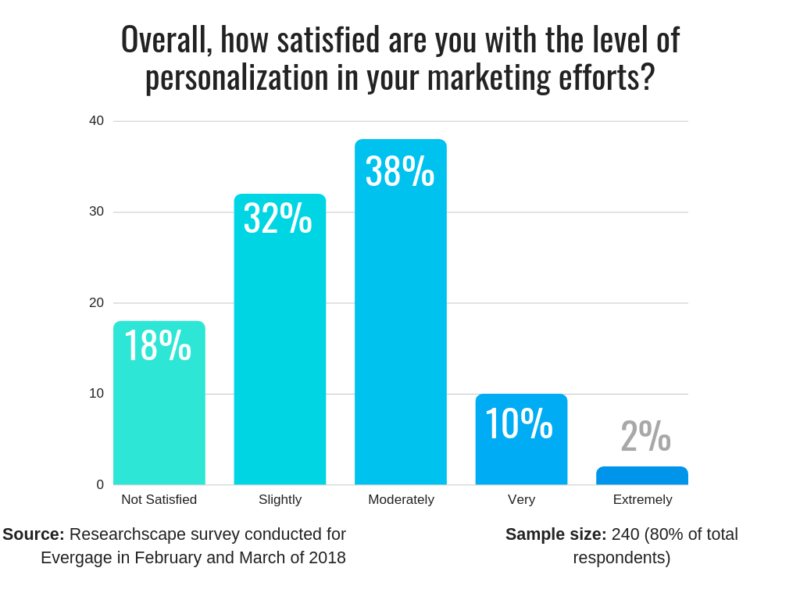How marketers can produce content that keeps up with the pace of personalization
- Fahad H

- Oct 24, 2018
- 3 min read
Personalization campaigns require content. Lots of it. So much, in fact, that earlier this month, Adobe released a study that showed that marketers are struggling to develop enough content to fuel effective personalization campaigns.
According to an Evergage study earlier this year, 96 percent of marketers acknowledge the power of personalization in managing customer relationships. But the Adobe study found that more than half (59 percent) find it difficult to personalize content at scale. Yet that’s exactly what they need to do.
Fortunately, there are many strategies and tools to help marketers keep up with content demand.
Step back and strategize. Todd W. Lebo, partner and CMO of Ascend2, says, “successful marketers prioritize the development of their strategy to meet the increasing demands of producing high-quality content for personalization campaigns.”
Lebo suggests that marketers consider what content can be repurposed for different segmentations and formats and then map that content to campaigns. Lebo says an editorial calendar can help marketers stay focused.
Automate and simplify. Paige O’Neill, CMO for Sitecore, says the problem of content creation is exacerbated by outdated, ineffective martech stacks.
“Marketing departments are struggling under the weight of complex, cobbled-together martech stacks that aren’t integrated and, as a result, slow down content planning, production, sharing, and distribution. It’s exactly the opposite of what marketers are trying to accomplish,” O’Neill said.
O’Neill, whose company just acquired digital asset management (DAM) and content marketing platform Stylelabs, said a unified technology platform can help streamline the content creation and production lifecycle.
“… If you think of content as the fuel for your business, then you quickly realize that people and processes can only take you so far if you don’t also invest in the right technology infrastructure to hold it all together,” O’Neill said.
Let templates do the heavy lifting. Even though the very nature of personalization requires developing separate customer journeys for different types of customers, there’s some content that can be used across platforms. John Raguin, CMO of Seismic, whose Live Docs is a template tool, says templated content can help any size company create huge amounts of content easily.
Julia Enthoven, founder and CEO of video editor Kapwing, says that templates and easy-to-use tools facilitate content creation.
“It used to be that content creators made a few pieces of content per week,” Enthoven said. “Now, modern brands are demanding many content pieces every day for their social channels, sales strategies, internal sites, and product demos. Creative professionals need tools to make and share a template that any colleague can customize so that they aren’t a bottleneck in production.”
“Right now, creative professionals do both production and post-production work, like personalization, sizing, subtitling, and optimization. We need new tools to distribute the simple post-production tasks across the team,” Enthoven said.

No more silos. Cynthia Countouris, SVP of marketing and product at mobile management platform MomentFeed, says marketers should “focus on creating a comprehensive approach that aligns efforts across all marketing functions and users, as opposed to point solutions that are very difficult to oversee and maintain.”
“… Comprehensive solutions allow for holistic reporting and monitoring so that marketers can gain better insights into what’s working where and further optimize their performance over time,” Countouris said.
Trust AI to help. Meredith Cooper, director of product marketing at Adobe Creative Cloud, says successful brands leverage artificial intelligence (AI) to personalize and scale.
“This ranges from using AI to create infinite variations that are specific to each consumer based on their preferences to using AI to cut down on the time spent doing tedious tasks like image cropping and tagging,” Cooper said.
Sundip Patel, VP of product at image delivery system Filestack, says automation and AI are not only necessary for creating content, they’re also important for managing the content created.
“Your content needs to go through a funnel that optimizes, categorizes, tags and transforms UGC [user-generated content] at scale,” Patel said in a company blog post. “It needs to be handled by your own robot army, faithfully reading the text in images with OCR, detecting faces, resizing, compressing, optimizing. We shouldn’t be intimidated by the rise of Big Content. After all, the same technology that has grown to allow content creation to scale provides us with everything we need to scale our content management as well.”
Stay tuned. If you’re a small to medium-sized business and you’re still using manual methods to create and manage your content, automation will take your efforts to the next level. Consider processes and templated tools to make the process easier and more effective.
If you’re a larger business or enterprise working with a martech stack that’s outdated, the time has come to look at a new solution, or sets of solutions. It’s worth the expense; at least for the near future, personalized campaigns are here to stay.








Comments